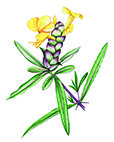Common name: Hop-headed Barleria
Lao name: Salet phang phone
Barleria lupulina
Acanthaceae family
Being both useful and pretty will get you a long way in the plant world. Barleria Lupulina, or Hop-headed Barleria, originated in Madagascar and thence travelled all around the Indian Ocean to most tropical areas, with 120 species found in Asia and Africa alone.
A decorative plant, it’s a metre-high shrub with narrow, dark green, red-veined leaves and dark red stems with soft pale thorns. The exuberant flowers sprout from a central spike closely covered in dark green overlapping scales, like a pine cone or a beehive ginger.
Barleria lupulina gets its first name from a 17th century botanist monk, Jacques Barrellier.
The second, lupulina (meaning wolf in Latin) is more gruesome. The story is that it resembles a European plant called hops, which is a vine that clings tightly to trees, sucking the sap like a wolf devouring its prey. So the Lao plant innocently bears a name hinting at a dark past.
In Laos, the plant is called salet phang phone, and some people add the word phou at the end, meaning ‘male’. They say there is a ‘female’ variety with no thorns and a male with thorns. But botanists say that the so-called ‘female’ plant is another species, barleria prionitis that has not yet ever been seen in Laos.
This is because botany in Laos still has a long and interesting way to go. Pha Tad Ke is the first and only botanic garden in the country, and we’ve just recently opened! We are working to find out more about Laos’ undocumented species, as well as educating visitors about biodiversity in Laos.
In Laos, salet phang phone is planted in gardens for the flowers and distinctive leaves, but it’s both vigorous and hardy and often escapes. (In Australia, it is considered an invasive species.) In Laos, people use it medicinally, so its proliferation is a good thing.
Local practitioners mainly prescribe it for skin problems. Fresh leaves are crushed and mixed with a little alcohol and applied to abscesses, mosquito bites and cold sores to soothe inflamed tissue. The roots are also used in the same way for centipede bites. In Thailand, oil extracted from the plant is sold commercially to reduce the pain of sore muscles.
So these pretty flowers can be more than simply decoration in a garden – they can help soothe the aches and pains of too much work in the garden as well.

The flower head of Barleria lupulina
Text by Dr Biba Vilayleck, PTK Resident Ethnobotanist, with translation by Suzy Young
Drawing by, and copyright owned by, Kongndern Sengdee, PTK Artist


